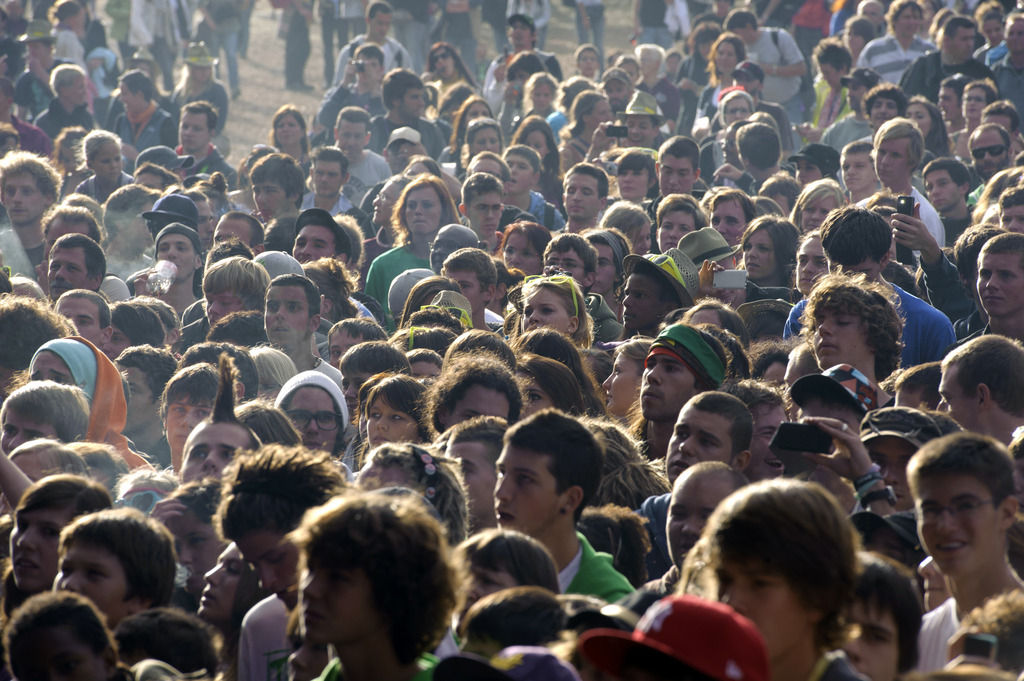Eight million and rising – can Switzerland cope?

The Swiss population is about to pass the eight-million mark and is set to continue to grow strongly in the coming years. But the small, densely populated alpine nation is struggling to keep pace with this recent demographic boom.
Daniel Müller-Jentsch, an economist and migration expert at the free-market liberal Swiss think tank Avenir Suisse, talks to swissinfo.ch about the consequences of this growth and the challenges ahead.
Over the past decade the Swiss population has grown rapidly from 7.2 to 8 million, driven by large numbers of qualified workers from Europe who have settled mainly in the Lake Geneva and Zurich regions.
The rise in immigration followed the gradual opening up of the labour market to European Union citizens in 2002 as part of the package of bilateral agreements.
swissinfo.ch: What are the main challenges Switzerland faces due to demographic growth?
Daniel Müller-Jentsch: The key driver of immigration is demand from the labour market for qualified staff. The workforce in Switzerland has expanded by ten per cent over the past decade and thus immigration from the EU has been the main source of the country’s economic boom in the 2000s. But the negative side effects are now coming to the fore caused by the speed of population growth and its cumulative effect over the years.
The traffic system, both the road and rail networks, is increasingly congested and reaching its capacity limits. In the central Plateau region, where two-thirds of the population live, urban sprawl has become a widespread concern.
Real estate prices have risen sharply over the past five to ten years, especially in certain hotspots like the Lake Geneva and Zurich regions, and in low-tax cantons like Schwyz and Zug. In certain prestigious holiday destinations they have literally gone through the roof.
swissinfo.ch: But isn’t Switzerland currently investing massively in its transport system, especially the railway?
D.M.-J.: Rail investment per capita is approximately ten times the level in Germany. Switzerland continuously expands and improves its transport system, but still can’t keep up with demand.
In rail and public transport, users only pay 40 per cent of total costs and the high levels of subsidies inflate demand artificially. Yet there is very low political acceptance for the necessary reforms such as higher prices. As a result, the system is being pushed to its limit.
swissinfo.ch: You say there is a housing problem but if you drive through Switzerland you see cranes everywhere.
D.M.-J.: Switzerland has indeed experienced a building boom in recent years, but it’s still not enough to keep up with the fast pace of population growth.
A key challenge is to increase the density of the major urban areas. Many efforts are underway like the redevelopment of brownfield sites, the renewal of the housing stock and amendments to building laws that allow higher densities. But all this takes time.
swissinfo.ch: Urban sprawl has been a problem for years but over the past decade has got worse. What should be done?
D.M.-J.: The biggest reform of federal planning laws since the 1980s is underway and there is a broad consensus that this is badly needed. The law has just passed parliament, but there is likely to be a referendum against it as some cantons like the Valais oppose some of the stricter rules associated with the reform.
swissinfo.ch: As an alternative to adapting to this demographic growth can we expect a tighter immigration policy?
D.M.-J.: The majority of the population is aware of the economic benefits of the recent immigration, but there is growing unease about the negative side effects that are becoming more pronounced – traffic jams, housing shortage, rising cost of living and urban sprawl.
Given the fact that Switzerland has direct democracy, sooner or later this unease could translate into a vote for more restrictive immigration policies. And that poses a risk.
Two-thirds of immigrants currently come from the EU and Switzerland has no unilateral control over those inflows. If it revoked the bilateral agreement on the free movement of people, the whole system of bilateral agreements with the EU would be put in peril and the economic price – in terms of more restricted access to the single market – could be high.
swissinfo.ch: So we could expect a public backlash in Switzerland?
D.M.-J.: Any country with such levels of immigration, both in terms of speed and magnitude, is bound to experience a counter reaction. That’s natural. The 70,000 net immigration per annum in Switzerland would be equivalent to 600,000 in France or 800,000 in Germany – and that over an extended number of years.
I’m rather amazed at the tolerance to immigration in Switzerland, which partly results from its long history of immigration and the fact that it has a privileged migrant mix. Most new immigrants come here to work, are well qualified and speak one of the three national languages as their mother tongue. This facilitates their integration. But there are limits.
swissinfo.ch: The Federal Statistics Office predicts between nine and 11.3 million permanent residents by 2060, according to their mid and high forecasts. What’s your feeling?
D.M.-J.: Their projections have regularly erred on the low side. Given past experience, the high-case scenario tends to be more realistic. I expect nine million in 2030, but would be cautious to make projections further into the future.
My feeling is that the current growth rate will continue for some time. Switzerland has had full employment for a long time, demand for workers is still relatively strong and the Swiss economy has been amazingly resilient to the financial and economic crises.
The composition of immigration in terms of nationality might change though. In the past there were mainly Germans, French and Italians due to geographical and linguistic proximity.
But in Germany, the economy is doing very well right now. Unemployment has decreased dramatically over the past five years – down from five million to less than two million. Neighbouring German regions like Bavaria and Baden Wurttemberg virtually have full employment today, so one of the main pools of immigrant workers is slowly drying up.
The effect is not yet visible in the statistics, but we may see a shift away from Germany and more towards EU countries with high levels of unemployment.
There were 7,971,300 people living in Switzerland at the end of March 2012 – a 1.2% rise over 15 months.
Some 23 per cent of the total, 1,828,400 people, were foreigners. The majority of new arrivals at the end of 2011 were Germans (+12.6%), followed by Portuguese (+11,1%), Kosovars (+8,9%), French (+4,4%) and Eritreans (+2,6%).
Two-thirds of new immigrants since 2002 are aged 20-39 and 53 per cent have a university degree.
Swiss birth rate: 1.48 children per Swiss woman. Population density on central Plateau region: 400 inhabitants per km2 – comparable with the Netherlands. 75 per cent of Swiss people live in urban areas. Life expectancy in 2008: 84.4 (women), 79.7 (men).
Philippe Wanner, Geneva University: Switzerland is a rich country so it shouldn’t be pessimistic about its future demographic growth.
It’s clear that there are frustrations among the population caused by growth via immigration. The nationalistic aspect is very present and is a risk for social cohesion.
Martin Schuler, Lausanne’s Federal Institute of Technology (EPFL): The main challenge is infrastructure. With or without population growth, we have reached a point where we need to invest massively.
The growth of outlying suburbs is mainly caused by Swiss residents as a reaction to the growth of towns and cities. We have to get Swiss people to change and adopt a denser model.
As in the 60s, we are in a phase where the environmental and demographic aspects have converged and the need to put the brakes on immigration is expressed.
Switzerland benefits from the fact that most of today’s immigrants are young, highly qualified people who trained elsewhere and these costs are not paid by Switzerland.
Nowadays there is less political reaction to counter regional imbalances like there were 30-40 years ago.
The big ageing problem will come in 2030 when there will be more retired people than those actively working and more elderly people will need special care.
Michel Oris, Geneva University: In the 1950s Switzerland witnessed massive immigration of mainly Italians who did the work the Swiss didn’t want to do. Over the past 20 years we’ve seen a double intake of people like cleaning women from Sri Lanka and Serbia, as well as university professors and bankers from Europe. They have helped Switzerland become the champion of innovation and ensured demographic, economic and social growth.

In compliance with the JTI standards
More: SWI swissinfo.ch certified by the Journalism Trust Initiative












You can find an overview of ongoing debates with our journalists here . Please join us!
If you want to start a conversation about a topic raised in this article or want to report factual errors, email us at english@swissinfo.ch.